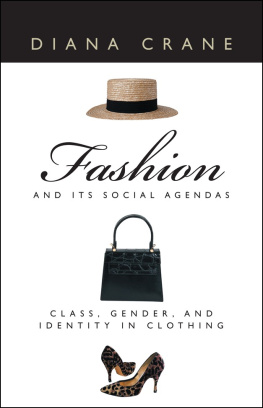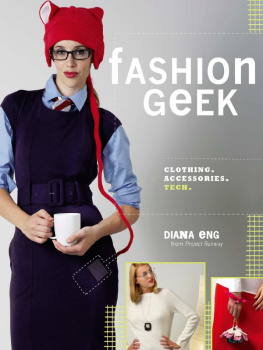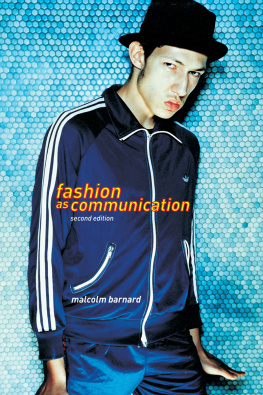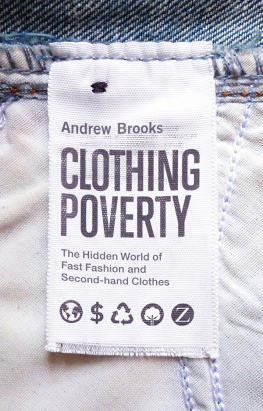The University of Chicago Press, Chicago 60637
The University of Chicago Press, Ltd., London
2000 by The University of Chicago
All rights reserved. Published 2000
Printed in the United States of America
15 14 13 12 11 10 09 6 5 4 3
ISBN 0-226-11799-5 (paper)
ISBN 978-0-226-92483-0 (e-book)
Library of Congress Cataloging-in-Publication Data
Crane, Diana, 1933
Fashion and its social agendas : class, gender, and identity in clothing / Diana Crane.
p. cm.
Includes bibliographical references and index.
ISBN 0-226-11798-7 (alk. paper)
1. CostumeSocial aspects. 2. FashionSocial aspects. 3. Social class. 4. Gender identity. 5. Group identity. 6. Costume and sexuality. I. Title.
GT525.C75 2000
This book is printed on acid-free paper.
During the eleven years that I have been researching various aspects of fashion and clothing choices, I have received assistance from many different sources. I am most grateful to the men and women who were interviewed for the studydesigners, fashion forecasters, and public relations staffand to the women (and a few men) who participated in the focus groups on fashion photographs and clothing advertisements.
The assistance of librarians was essential to this study. I thank particularly Franoise Blum and Michel Prat at the library of the Centre dEtudes de Documentation, dInformation, et dActions Sociales in Paris, which owns a complete set of Frdric Le Plays publications, for their assistance in obtaining copies of the case studies conducted by Le Play and his associates of French working-class families in the nineteenth century. I am especially grateful to Antoine Savoye, specialist in the works of Le Play, who made me aware of the existence of this unique archive.
I am also indebted to numerous reference librarians at the Bibliothque Forney in Paris and at the Van Pelt Library of the University of Pennsylvania, and particularly Lauris Olson and Lee V. Pugh, assistant director of the Inter-library Loan Department. I also thank Franoise Ttart-Vittu of the Muse de la Mode de la Ville de Paris (Muse Galliera).
In the early stages of my research, I received a Fulbright Senior Research Award. I thank the Department of Sociology at the University of Pennsylvania for providing a sabbatical year in 199596 and for allocating funds for research and clerical assistance in conducting and transcribing focus-group sessions.
Linda Mamoun and Kesha Moore provided invaluable assistance as focus-group leaders. Christine Holmes and Bonita Iritani performed the difficult job of transcribing the tapes. Tina Nemetz was always ready and able to solve administrative problems. I also thank Waddick Doyle at the American University of Paris for his assistance in locating focus-group participants.
I am grateful to Pierre-Michel Menger of the Centre de Sociologie des Arts in Paris for inviting me to spend a month at the Ecole des Hautes Etudes en Science Sociales and to present my research in his seminar at the Ecole during the year 199596.
Judith Adler, Susan Kaiser, and Toba Kerson devoted precious time to reading and commenting on an earlier version of the manuscript. Their advice and suggestions were invaluable. I especially appreciate Tobas interest in the study from its earliest stages, which manifested itself in the form of clippings and articles that would otherwise have been inaccessible to me.
I am grateful to Douglas Mitchell at the University of Chicago Press for his long-standing interest in my work and Robert Devens for his assistance with the onerous process of preparing a volume with fifty-eight illustrations for publication. I also thank the press for a small grant to partially cover photographic reproduction fees.
Finally, Michel Herv and Adrienne Herv provided moral support and were always available with advice and assistance. They exhibited their usual patience and stoicism when confronted with the ordeal of sharing their lives with a manuscript-in-progress.
Portions of the book, in somewhat different form, have appeared in the following publications.
Fashion Design as an Occupation: A Cross-National Approach. Pp. 5573 in Current Research on Occupations and Profession, vol. 8: Creators of Culture, ed. M. Cantor and C. Zollars. Greenwich, CT: JAI Press, 1994. Reprinted with permission.
Postmodernism and the Avant-Garde: Stylistic Change in Fashion Design. Modernism/Modernity 4 (1997): 12340. 1997. The Johns Hopkins University Press.
Globalization, Organizational Size and Innovation in the French Luxury Fashion Industry: Production of Culture Theory Revisited. Poetics: Journal of Empirical Research on Literature, the Media, and the Arts 24 (1997): 393414. Copyright 1997. Reprinted with permission from Elsevier Science.
Clothing Behavior as Non-Verbal Resistance: Marginal Women and Alternative Dress in the Nineteenth Century. Fashion Theory 3 (1999): 24168. Reprinted with permission from Berg Publishers.
Women Fashion Designers and Womens Experience. Journal of American Culture 22, no. 2 (summer 1999): 18. Reprinted with permission from Bowling Green State University Popular Press.
Diffusion Models and Fashion: A Reassessment. The Annals of the American Academy of Political and Social Science 566 (November 1999): 1324. 1999 by The American Academy of Political and Social Science. Reprinted with permission.
Gender and Hegemony in Fashion Magazines: Womens Interpretations of Fashion Photographs. Sociological Quarterly 40, no. 4 (Fall 1999): 54163. 1999 by The Midwest Sociological Society. Reprinted with permission.
Clothing, as one of the most visible forms of consumption, performs a major role in the social construction of identity. Clothing choices provide an excellent field for studying how people interpret a specific form of culture for their own purposes, one that includes strong norms about appropriate appearances at a particular point in time (otherwise known as fashion) as well as an extraordinarily rich variety of alternatives. One of the most visible markers of social status and gender and therefore useful in maintaining or subverting symbolic boundaries, clothing is an indication of how people in different eras have perceived their positions in social structures and negotiated status boundaries. In previous centuries, clothing was the principal means for identifying oneself in public space. Depending on the period, various aspects of identity were expressed in clothing in Europe and the United States, including occupation, regional identity, religion, and social class. Certain items of clothing worn by everyone, such as hats, were particularly important, sending instant signals of ascribed or aspired social status. Variations in clothing choices are subtle indicators of how different types of societies and different positions within societies are actually experienced.
Recently, sociologists have begun to understand the power of artifacts to exercise a kind of cultural agency, influencing social behavior and attitudes in ways that we often fail to recognize. Technology embodied in machinery, architecture, and computers (to name a few) is a major influence in modern life (Latour 1988) and has tended to obscure the fact that nontechnological artifacts have been influencing human behavior for centuries. Clothes as artifacts create behavior through their capacity to impose social identities and empower people to assert latent social identities. On the one hand, styles of clothing can be a straitjacket, constraining (literally) a persons movements and manners, as was the case for womens clothing during the Victorian era. For centuries, uniforms (military, police, religious) have been used to impose social identities on more or less willing subjects (Joseph 1986). Alternatively, clothing can be viewed as a vast reservoir of meanings that can be manipulated or reconstructed so as to enhance a persons sense of agency. Interviews by social psychologists (Kaiser, Freeman, and Chandler 1993) suggest that people attribute to their favorite clothes the capacity to influence the ways they express themselves and interact with others.








